By Elanor Wang
This year, 145 local and overseas galleries are attending ART TAIPEI 2023. For those in the industry, it is the largest art exhibition in Taiwan; for enthusiasts who are trying to become more in touch with art and exhibitions, it is the perfect opportunity to step into the art world. Taiwan's art and aesthetic environment has changed rapidly in the past decade, especially during the pandemic, transforming swiftly from exhibition scenes dominated by senior collectors to social scenes for young collectors and art lovers.
In view of the growing influence of the community on Taiwan's art market and aesthetic environment, we specially invited Berlin Chen, also known as Zi Yu in “Zi Yu‘s House of Pedant”, to have a conversation with Yu Chen, the host of “Art. Market”. As collectors who are active in the community and share their opinions generously, how do they gather information to create their perspectives? How do they view today’s aesthetic environment and market trends? In addition, they specifically mentioned in the conversation that "losing money is an important experience." For various exciting content, please see the discussion:

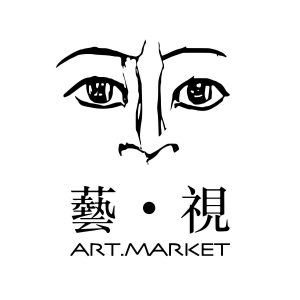
Zi Yu, in “Zi Yu‘s House of Pedant” (photograph courtesy of Zi Yu‘s House of Pedant)
Yu Chen, the host of “Art. Market”(photograph courtesy of Art. Market)
Q: If a newcomer wants to start paying attention to market and aesthetic trends, what would you recommend they do?
Zi Yu: if you don’t have any information, you can go to the art sections of Tsutaya and Eslite bookstores, as well as Huashan 1914 Creative Park, etc. to obtain keywords and information. After becoming familiar with it, you can then read domestic art media, or refer to foreign websites and auction houses, and use social platforms to search for content you are interested in, and get the information actively pushed out by the online algorithms.
Yu Chen: The official website of the auction house, exhibition previews, art fairs and exhibitions are all the channels through which I obtain information. Next are the social platforms. I follow keywords such as Art, Art News and Design through X (formerly known as Twitter) to get real-time information. I also follow the Chinese market through WeChat, Xiaohongshu(Red Booklet) and Tik-Tok, but the most important thing is to integrate these things into my life.
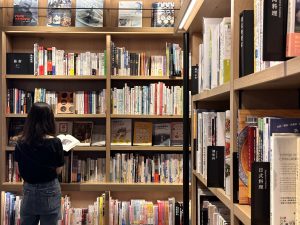
The general public browsing books in the art section at Tsutaya Bookstore. (Photograph courtesy of Elanor Wang)
Q: How do you develop your own perspectives after gathering the information?
Zi Yu: Reading the history of art, design and architecture is helpful. After understanding your own preferences, you can continue learning through keywords. The establishment of perspectives does not depend on piling on information, but on removing unnecessary information. Modern society has a huge amount of information, which requires systematic training to process and identify information. For example, the wabi-sabi style of interior decoration that is popular right now is different from real wabi-sabi, but not everyone may know the difference.
Yu Chen: Everyone’s sense of aesthetics is different, but art history is very important. For example, Mr. Doodle was very popular a few years ago, but if you understand the history of American art in the 20th century, you will realize that his style is similar to Keith Haring. The reason why Mr. Doodle was so popular in the market may be because buyers cannot afford Keith Haring, or did not know who Keith Haring is, so it would be reasonable for the former to buy Mr. Doodle at a lower price. But when the price of Mr. Doodle was similar to that of Keith Haring, why not just collect Keith Haring? Therefore, it is important to understand history. Start with personal aesthetics first, and then study history and the market.
Zi Yu: I have encountered galleries that avoid talking about the historical context behind contemporary art. This is pretty awful. The work itself is good, but the context is also essential.
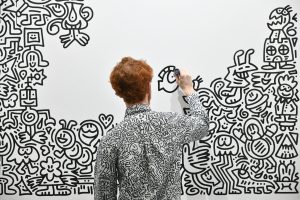
Mr. Doodle composing a work live at J.P. Art Center’s booth at ART TAIPEI 2019. (Photograph courtesy of ART TAIPEI)
Q: In recent years, "exhibition viewing" has become a social activity or a community currency. How do the two of you view the changes in Taiwan's aesthetic environment?
Yu Chen: Art used to be the talk of gatherings within the circle, but with the rise of social platforms, which fairs and exhibitions to go to, what to collect, etc. had quickly spread through these platforms, which in turn attract more people to flock to the scene. I don’t think this growth is negative, but rather represents the fact that the current society is a stable one, where people have enough time and space to pursue things of a spiritual aspect.
Zi Yu: Generally speaking, I think this is a long-term impact caused by policies. In President Chen Shui-Bian’s era, there was a push for transformation of industries, with resources pouring into design schools. In President Ma Ying-Jeou’s era, cultural and creative industries were promoted, where it was hoped design would help traditional industries to transform into brands, but this was not what the traditional industries needed. Students from design schools have moved into other industries after graduation, and now that they have social status and disposable income, what they have learned in the past has made them willing to pay more for aesthetics. For example, 15 years ago, there were not so many stores and products that emphasized personal taste and design. In addition, the rise of social platforms has prompted people to pursue more feedback on a visual level, which has also made exhibitions more sophisticated. The superposition of various factors, the large demand for beauty and aesthetics has pushed society forward once more, and the wealth in society also means people are more willing to invest in aesthetics education.

Many products are loved by the public because of their design and aesthetics,
like Auspic Paper’s “Nooks and Crannies” (Photograph courtesy of Elanor Wang)
Q: How do the two of you view the changes in aesthetics in recent years? Have you adjusted your collection in response to this?
Zi Yu: Artworks are luxury items and one cannot buy art based on popularity. As soon as the trend fades, an artwork can become a joke. For example, in recent years, there have been co-branded products between luxury brands and artists, but as time passes, these products look outdated if you continue to use them. When buying art, one cannot chase the trend. One must have their own aesthetics so as not to be affected by what is the popular. On the other hand, if one has one’s own aesthetics, caring about whether the artwork is popular or not after purchasing it will not become a factor. Two years ago, many people were chasing NFT and many media outlets were adding fuel to the fire at that time. Now, two years later, a lot of collectors have lost all the money they sunk into NFTs. If you are simply chasing the trend and are worried about whether you will lose money, you would be better off buying stocks.
Yu Chen: Every era has its own pop culture, but as Zi Yu said, if one genuinely likes it from the heart and is not influenced by the popularity, then feel free to like it. For example, I like Mr. Doodle very much. I don’t care about the ups and downs in the prices of his works or market discussions, and hanging up my favorite work of his at home brings me joy. If you pursue trends from an investment perspective, when the trend changes, you will get angry every day when you go home and see the painting on the wall. I believe it’s important to differentiate between personal liking and investment, to know whether one truly likes a piece of art, or is it just keeping the art for a few years in order to make a profit. If it is the former, then it does not matter if the price falls. If it is an investment, then making a profit or a loss are all just part of the game. My personal collection was originally focused on expat Chinese artists of the 20th century, but in the past few years, I have experienced some trend changes when doing podcasts, and have been drawn in by the contemporary trends or NFTs. However, I clearly know how much money I have sunk into this area, and I’m OK if I lose all that I’ve invested in this area. This doesn't matter because my goal is to understand the market through actual practice and to lend real substance to my statements and discussions.
Zi Yu: I think the first thing to do when buying art is to be willing to lose money. It is very vital to have lost money, as the feeling will be different.

Being trendy is not the focus for collecting.
A work you like makes you happy every day when it is hanging on the wall
(Photograph courtesy of ART TAINAN)


The ART TAIPEI 2022 VIP |VIP NFT (front), designed through the use of algorithms (Photograph courtesy of ART TAIPEI)
The ART TAIPEI 2022 VIP |VIP NFT (back), designed through the use of algorithms (Photograph courtesy of ART TAIPEI)
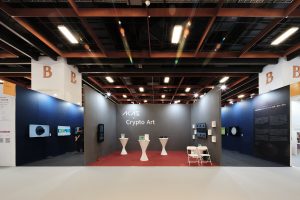
The Crypto Art Zone exhibition area at ART TAIPEI 2022 (Photograph courtesy of ART TAIPEI)
Q: What’s the definition of losing money?
Zi Yu: Regret. Sometimes after you buy it, you regret it. This is important because its existence reminds you to pay more attention to your taste and actions. Many people around me are scared of regret or drop in market value after they buy a piece. However, even if you pick and choose to find your favorite work at the best price, you may still end up regretting it. The experience of regret is priceless, and those who have regretted something can understand it, while those who have not regretted something don’t want to experience it.
Yu Chen: Losing money is normal. As long as you can accept you’re losing money, you can be more open-minded about many things, whether it is collecting art or investing.
Q: What advice would you give to novice collectors attending ART TAIPEI?
Zi Yu: Practice "inquiry after prices", especially if you like something but think it is too expensive and are hesitant to ask about it. Speaking up is the first step. Have a base price in mind, and then ask about the price. You will gradually better understand with what price and mentality you should have when viewing a work.
Yu Chen: Treat it as a part of life;, don’t put too much pressure on yourself. Focus on your own aesthetic and take note of what you like for ongoing research.
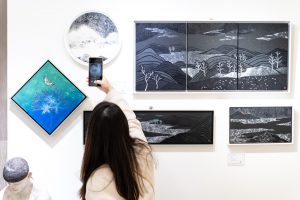
Document the works you like and continue to do research (Photograph courtesy of ART TAINAN)
During the discussion, Zi Yu and Yu Chen shared their views on ways of appreciating art, the development of aesthetic styles, and the growing trend of society attending exhibitions. Their views are similar at times and contradictory at others, but they were able to explain the current situation in contemporary Taiwan from different angles. It can be seen that in the world view of art appreciation, establishing one's own references and orientation is a relatively important prerequisite.
The two individuals also offered numerous reminders that art appreciation should be integrated into one’s life. Through the accumulation of aesthetic experiences in life, one can gradually absorb knowledge and eliminate the non-essentials to establish one's own aesthetic system. Only in this way can the influences from external trends and deliberately pursuit of those trends be avoided. Having one’s own aesthetic point of view also helps to clarify the difference between investing and collecting.
The most important thing is to be brave on the path of art appreciation and collection. For those who are new to the field of appreciation, they must be brave enough to inquire; and for those who are new to the world of collecting, they must be mentally prepared to lose money. Losing money is not entirely negative; what is more important is the implication that it leads to the reconstruction of one’s aesthetic system, which is a priceless and essential component when one looks at collecting art.
